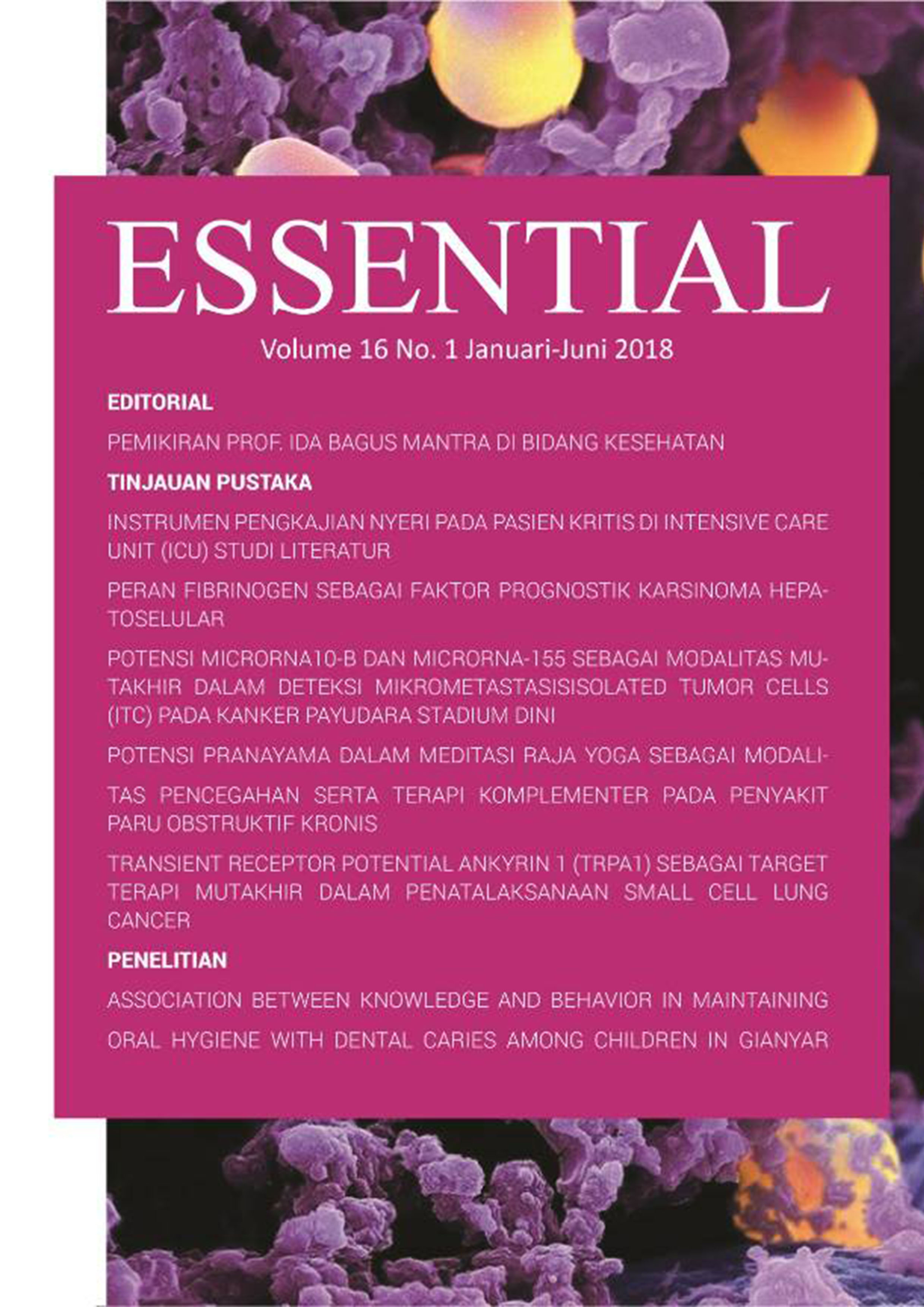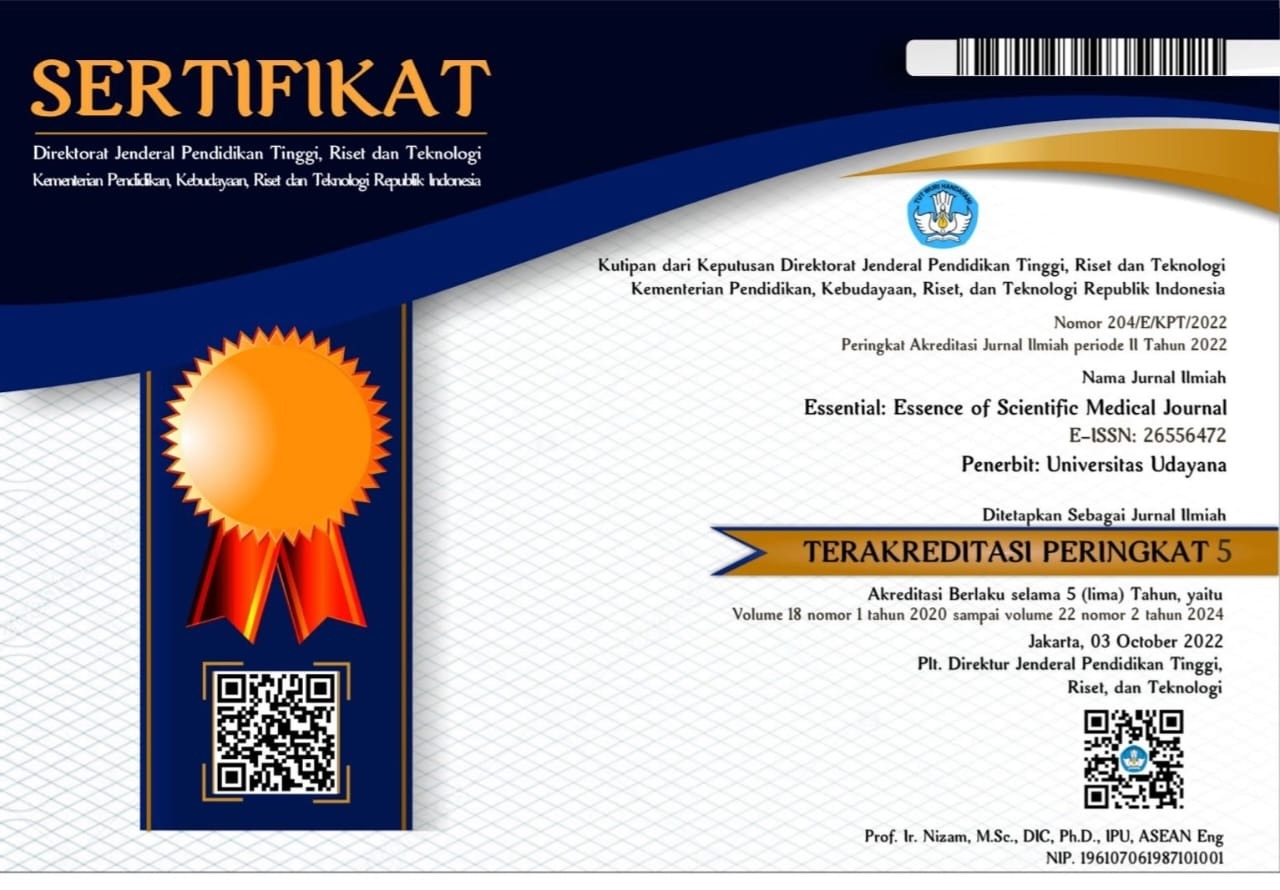ASSOCIATION BETWEEN KNOWLEDGE AND BEHAVIOR IN MAINTAINING ORAL HYGIENE WITH DENTAL CARIES AMONG CHILDREN IN GIANYAR
Abstract
Background: The prevalence of dental caries among children in South East Asia, Indonesia, and Bali was 95%, 72%, and 22.5%, respectively. Dental caries in children can lead to another serious comorbidity of systemic problem such as diabetes and cardiovascular disease. The development of dental caries among children is influenced by their knowledge and behavior in maintaining oral hygiene.
Purpose: The purpose of this study was to determine the association of knowledge and behavior in maintaining oral hygiene with dental caries status among children in Gianyar, Bali.
Method: A Cross-sectional analytic study design was used to determine the association between the variables. The sample size of this study was 70 and consist of 7-8 years old state elementary school children. Bivariate and multivariate statistical analysis was performed in this study.
Results: This study showed that 94.3% of the participant had dental caries. There is no significant association between knowledge in maintaining oral hygiene and dental caries (P=0.743). However, there is a significant association between behavior in maintaining oral hygiene and dental caries (P=0.011).
Conclusion: Poor behavior and knowledge in maintaining oral hygiene among children are not associated with the presence of dental caries. However, education and practice lesson in maintaining oral hygiene should be directed to the lower categories of each group.
Downloads
References
2. Wang J-D, Chen X, Frencken J, Du M-Q, Chen Z. Dental caries and first permanent molar pit and fissure morphology in 7- to 8-year-old children in Wuhan, China. Int J Oral Sci [Internet]. 2012;4:3:157–60. Available from: http://www.pubmedcentral.nih.gov/articlerender.fcgi?artid=3464983&tool=pmcentrez&rendertype=abstract
3. Ghazal TS, Levy SM, Childers NK, Broffitt BA, Caplan DJ, Warren JJ, et al. Dental Caries in High-Risk School-Aged African-American Children in Alabama: A Six-Year Prospective Cohort Study HHS Public Access. Pediatr Dent. 2016;38:3:224–30.
4. Supriatna A, Putri R, Fadillah N, Nawawi AP. Description of dental caries on mixed dentition stage of elementary school students in Cibeber Community Health Center. Padjadjaran J Dent. 2017;29:3:153–7.
5. Sondik EJ, Madans JH, Gentleman JF. Oral Health Status and Access to Oral Health Care for U . S . Adults Aged 18 – 64 : National Health Interview Survey , 2008. Hyattsville; 2012.
6. Firmino RT, Ferreira FM, Paiva SM, Granville-garcia AF, Fraiz FC, Martins CC. Oral health literacy and associated oral conditions. J Am Dent Assoc [Internet]. 2017;1–10. Available from: http://dx.doi.org/10.1016/j.adaj.2017.04.012
7. Sarah Dallas, Dr Judy Li, Kerri Kruse DKM-H. A Literature Review on Oral Health in Preschoolers. Lit Rev [Internet]. 2015 [cited 2017 May 23]; Available from: http://www.hpa.org.nz/sites/default/files/Literature review oral health.pdf
8. Duangthip D, Gao SS, Chin E, Lo M, Chu CH. Early childhood caries among 5- to 6-year-old children in Southeast Asia. Int Dent J. 2017;67:98–106.
9. Moreira R da S. Epidemiology of Dental Caries in the World. In: Virdi M, editor. Oral Health Care – Pediatric, Research, Epidemiology and Clinical Practices [Internet]. Prof. Mand. Rijeka: InTech; 2012. p. 159. Available from: http://www.intechopen.com/books/oral-health-care-pediatric-research-epidemiology-andclinical-practices/epidemiology-of-dental-caries-in-the-world
10. Indonesia BP dan PKKKR. Riset Kesehatan Dasar Riskesdas 2013 [Internet]. 2013. Available from: http://www.depkes.go.id/resources/download/general/Hasil Riskesdas 2013
11. Ayu M, Suratri L, Setiawaty V. Correlation between dental health maintenance behavior with Dental Caries Status ( DMF-T ). Bali Med J. 2018;7:1:56–60.
12. Heaton B, Crawford A, Garcia RI, Henshaw M, Riedy CA, Barker JC, et al. Oral health beliefs, knowledge, and behaviors in Northern California American Indian and Alaska Native mothers regarding early childhood caries. J Public Health Dent [Internet]. 2017; Available from: http://doi.wiley.com/10.1111/jphd.12217
13. Runnel R, Honkala S, Honkala E, Olak J, Nõmmela R, Vahlberg T, et al. Caries experience in the permanent dentition among fi rst- and second-grade schoolchildren in southeastern Estonia. 2013;August 2011:410–5. Jannah Z. Perbedaan Pengaruh Pendidikan Kesehatan Tentang Karies Gigi Melalui Media Buku Cerita Bergambar dan Leaflet Terhadap Pengetahuan, Sikap, dan Perilaku Anak Sekolah Dasar di Kabupaten Malang. 2016;
14. Pratiwi PE, Agung A, Sawitri S, Adiputra N, Pratiwi PE, Agung A, et al. Laporan hasil penelitian Hubungan persepsi tentang karies gigi dengan kejadian karies gigi pada calon pegawai kapal pesiar yang datang ke dental klinik di Denpasar tahun 2012 Correlation between perceptions with the occurance of dental decay among cruise . 2013;1:78–83.
15. Pratiwi NL. The Trend Analysis of the Availability of Dental Caries and Dental Health Personnel in Indonesia. Dentistry. 2016;6:2.
16. Agustin M, Irdawati, Zulaicha E. Efektifitas Pendidikan Kesehatan Media Booklet Dibandingkan Audiovisual terhadap Pengetahuan Orang Tua Tentang Karies Gigi pada Anak Usia 5-9 Tahun di Desa Makamhaji. 2014.
17. Ratnasari, Gultom E, Andriyani D. Tingkat keparahan karies dan status gizi pada anak sekolah usia 7 – 8 tahun. J Kep. 2014;10:1:33–7.
18. Lubis F, Sulastri, Jadmiko A. Perbedaan Pendidikan Kesehatan Menggunakan Metode Ceramah dan Audiovisual terhadap Tingkat Pengetahuan dan Sikap Perawatan Karies Gigi Anak di Wilayah Puskesmas Wonosegoro II. 2016.
19. Widayati N. Faktor yang Berhubungan dengan Karies Gigi Pada Anak Usia 4–6 Tahun. J Berk Epidemiol [Internet]. 2014;2:2:196–205. Available from: http://obstetri-ginekologi.fk.unair.ac.id/index.php/JBE/article/viewFile/175/45
20. Vallejos-sánchez AA, Medina-solís CE, Maupomé G, Casanova-rosado JF, Minaya-sánchez M, Villalobos-rodelo JJ. Sociobehavioral factors influencing toothbrushing frequency among schoolchildren. J Am Dent Assoc [Internet]. 2008;139:6:743–9. Available from: http://dx.doi.org/10.14219/jada.archive.2008.0256
21. Tinanoff N, Palmer CA. Dietary Determinants of Dental Caries and Dietary Recommendations for Preschool Children. Public Heal Dent. 2000;60:3:197–206.
22. Marshall TA, Broffitt B, Eichenberger-gilmore J, Warren JJ, Cunningham MA, Levy SM. The Roles of Meal , Snack , and Daily Total Food and Beverage Exposures on Caries Experience in Young Children. Public Heal Dent. 2005;65:3:166–173.
23. Knutson JW. Accomplishments That May Be Achieved And Methods Of Evaluating Local Public Health Dental Programs. Public Heal Dent. 1951;13:1:1–7.
24. Albino J, Tiwari T, Henderson WG, Thomas J, Bryant LL, Batliner TS, et al. Learning from caries-free children in a high-caries American Indian population. Public Heal Dent. 2014;74:4:293–300.
25. Baskaradoss JK. The association between oral health literacy and missed dental appointments. J Am Dent Assoc [Internet]. 2016;147:11:867–874. Available from: http://dx.doi.org/10.1016/j.adaj.2016.05.011
26. Mawuntu MM, Pangemanan DHC, Mintjelungan C. Gambaran Status Kebersihan Mulut Siswa SD Katolik ST. Agustinus Kawangkoan. e-GiGi. 2015;3:2:252–6.
27. Kadir Y. Hubungan Pengetahuan Kesehatan Gigi Anak Dengan Status Karies Gigi Molar Pertama Permanen Murid Kelas III-V SD IT Ar-Rahmah Tamalanrea. Hasanuddin; 2015.
28. S. Manikandan. Measures of central tendency: The mean. J Pharmacol Pharmacother. 2011;2:2:140–2.
29. World Health Organization. Oral Health Survey Basic Methods [Internet]. Fifth Edit. France: WHO Press; 2013. 73-5 p. Available from: (www.who.int/about/licensing/copyright_form/en/index.html
30. National Institute of Dental and Craniofacial Research. Dental Caries (Tooth Decay) in Children (Age 2 to 11) [Internet]. National Institute of Dental and Craniofacial Research. 2014 [cited 2017 Jan 30]. Available from: https://www.nidcr.nih.gov/DataStatistics/FindDataByTopic/DentalCaries/DentalCariesChildren2to11.htm
31. Shaffer JR, Leslie EJ, Feingold E, Govil M, McNeil DW, Crout RJ, et al. Caries Experience Differs between Females and Males across Age Groups in Northern Appalachia. Int J Dent. 2015;1–9.
32. Handayani H, Arifah AN. status kesehatan gigi siswa SMP / MTs Pondok Pesantren Putri Ummul Mukminin The relation of oral and dental health knowledge , attitude and behavior to the dental health status of student at SMP / Mts Pondok Pesantren Putri Ummul Mukminin. 2013;44–50.
33. Folayan MO, Kolawole KA, Oyedele T, Chukumah NM, Onyejaka N, Agbaje H, et al. Association between knowledge of caries preventive practices , preventive oral health habits of parents and children and caries experience in children resident in sub-urban Nigeria. BMC Oral Health [Internet]. 2014;14:156:1–10. Available from: http://www.biomedcentral.com/1472-6831/14/156%0APage
34. Castilho ARF de, Mialhe FL, Barbosa T de S, Puppin-Rontani RM. Influence of family environment on children’s oral health: a systematic review. J Pediatr (Versão em Port [Internet]. 2013;89:2:116–23. Available from: http://linkinghub.elsevier.com/retrieve/pii/S2255553613000207
35. Leghari MA. A pilot study on oral health knowledge of parents related to dental caries of their children- Karachi , Pakistan. Master Thesis. 2012;0–63.
36. Petersen P. The burden of oral disease: challenges to improving oral health in the 21st century. Bull World Heal Organ. 2005;83:1:3.
37. Wang J-D, Chen X, Frencken J, Du M-Q, Chen Z. Dental caries and first permanent molar pit and fissure morphology in 7- to 8-year-old children in Wuhan, China. Int J Oral Sci [Internet]. 2012;4:3:157–60. Available from: http://www.pubmedcentral.nih.gov/articlerender.fcgi?artid=3464983&tool=pmcentrez&rendertype=abstract
38. Ghazal TS, Levy SM, Childers NK, Broffitt BA, Caplan DJ, Warren JJ, et al. Dental Caries in High-Risk School-Aged African-American Children in Alabama: A Six-Year Prospective Cohort Study HHS Public Access. Pediatr Dent. 2016;38:3:224–30.
39. Supriatna A, Putri R, Fadillah N, Nawawi AP. Description of dental caries on mixed dentition stage of elementary school students in Cibeber Community Health Center. Padjadjaran J Dent. 2017;29:3:153–7.
40. Sondik EJ, Madans JH, Gentleman JF. Oral Health Status and Access to Oral Health Care for U . S . Adults Aged 18 – 64 : National Health Interview Survey , 2008. Hyattsville; 2012.
41. Firmino RT, Ferreira FM, Paiva SM, Granville-garcia AF, Fraiz FC, Martins CC. Oral health literacy and associated oral conditions. J Am Dent Assoc [Internet]. 2017;1–10. Available from: http://dx.doi.org/10.1016/j.adaj.2017.04.012
42. Sarah Dallas, Dr Judy Li, Kerri Kruse DKM-H. A Literature Review on Oral Health in Preschoolers. Lit Rev [Internet]. 2015 [cited 2017 May 23]; Available from: http://www.hpa.org.nz/sites/default/files/Literature review oral health.pdf
43. Duangthip D, Gao SS, Chin E, Lo M, Chu CH. Early childhood caries among 5- to 6-year-old children in Southeast Asia. Int Dent J. 2017;67:98–106.
44. Moreira R da S. Epidemiology of Dental Caries in the World. In: Virdi M, editor. Oral Health Care – Pediatric, Research, Epidemiology and Clinical Practices [Internet]. Prof. Mand. Rijeka: InTech; 2012. p. 159. Available from: http://www.intechopen.com/books/oral-health-care-pediatric-research-epidemiology-andclinical-practices/epidemiology-of-dental-caries-in-the-world
45. Indonesia BP dan PKKKR. Riset Kesehatan Dasar Riskesdas 2013 [Internet]. 2013. Available from: http://www.depkes.go.id/resources/download/general/Hasil Riskesdas 2013
46. Ayu M, Suratri L, Setiawaty V. Correlation between dental health maintenance behavior with Dental Caries Status ( DMF-T ). Bali Med J. 2018;7:1:56–60.
47. Heaton B, Crawford A, Garcia RI, Henshaw M, Riedy CA, Barker JC, et al. Oral health beliefs, knowledge, and behaviors in Northern California American Indian and Alaska Native mothers regarding early childhood caries. J Public Health Dent [Internet]. 2017; Available from: http://doi.wiley.com/10.1111/jphd.12217
48. Runnel R, Honkala S, Honkala E, Olak J, Nõmmela R, Vahlberg T, et al. Caries experience in the permanent dentition among fi rst- and second-grade schoolchildren in southeastern Estonia. 2013;August 2011:410–5.
49. Jannah Z. Perbedaan Pengaruh Pendidikan Kesehatan Tentang Karies Gigi Melalui Media Buku Cerita Bergambar dan Leaflet Terhadap Pengetahuan, Sikap, dan Perilaku Anak Sekolah Dasar di Kabupaten Malang. 2016;
50. Pratiwi PE, Agung A, Sawitri S, Adiputra N, Pratiwi PE, Agung A, et al. Laporan hasil penelitian Hubungan persepsi tentang karies gigi dengan kejadian karies gigi pada calon pegawai kapal pesiar yang datang ke dental klinik di Denpasar tahun 2012 Correlation between perceptions with the occurance of dental decay among cruise . 2013;1:78–83.
51. Pratiwi NL. The Trend Analysis of the Availability of Dental Caries and Dental Health Personnel in Indonesia. Dentistry. 2016;6:2.
52. Agustin M, Irdawati, Zulaicha E. Efektifitas Pendidikan Kesehatan Media Booklet Dibandingkan Audiovisual terhadap Pengetahuan Orang Tua Tentang Karies Gigi pada Anak Usia 5-9 Tahun di Desa Makamhaji. 2014.
53. Ratnasari, Gultom E, Andriyani D. Tingkat keparahan karies dan status gizi pada anak sekolah usia 7 – 8 tahun. J Kep. 2014;10:1:33–7.
54. Lubis F, Sulastri, Jadmiko A. Perbedaan Pendidikan Kesehatan Menggunakan Metode Ceramah dan Audiovisual terhadap Tingkat Pengetahuan dan Sikap Perawatan Karies Gigi Anak di Wilayah Puskesmas Wonosegoro II. 2016.
55. Widayati N. Faktor yang Berhubungan dengan Karies Gigi Pada Anak Usia 4–6 Tahun. J Berk Epidemiol [Internet]. 2014;2:2:196–205. Available from: http://obstetri-ginekologi.fk.unair.ac.id/index.php/JBE/article/viewFile/175/45
56. Vallejos-sánchez AA, Medina-solís CE, Maupomé G, Casanova-rosado JF, Minaya-sánchez M, Villalobos-rodelo JJ. Sociobehavioral factors influencing toothbrushing frequency among schoolchildren. J Am Dent Assoc [Internet]. 2008;139:6:743–9. Available from: http://dx.doi.org/10.14219/jada.archive.2008.0256
57. Tinanoff N, Palmer CA. Dietary Determinants of Dental Caries and Dietary Recommendations for Preschool Children. Public Heal Dent. 2000;60:3:197–206.
58. Marshall TA, Broffitt B, Eichenberger-gilmore J, Warren JJ, Cunningham MA, Levy SM. The Roles of Meal , Snack , and Daily Total Food and Beverage Exposures on Caries Experience in Young Children. Public Heal Dent. 2005;65:3:166–173.
59. Knutson JW. Accomplishments That May Be Achieved And Methods Of Evaluating Local Public Health Dental Programs. Public Heal Dent. 1951;13:1:1–7.
60. Albino J, Tiwari T, Henderson WG, Thomas J, Bryant LL, Batliner TS, et al. Learning from caries-free children in a high-caries American Indian population. Public Heal Dent. 2014;74:4:293–300.
61. Baskaradoss JK. The association between oral health literacy and missed dental appointments. J Am Dent Assoc [Internet]. 2016;147:11:867–874. Available from: http://dx.doi.org/10.1016/j.adaj.2016.05.011
62. Mawuntu MM, Pangemanan DHC, Mintjelungan C. Gambaran Status Kebersihan Mulut Siswa SD Katolik ST. Agustinus Kawangkoan. e-GiGi. 2015;3:2:252–6.
63. Kadir Y. Hubungan Pengetahuan Kesehatan Gigi Anak Dengan Status Karies Gigi Molar Pertama Permanen Murid Kelas III-V SD IT Ar-Rahmah Tamalanrea. Hasanuddin; 2015.
64. S. Manikandan. Measures of central tendency: The mean. J Pharmacol Pharmacother. 2011;2:2:140–2.
65. World Health Organization. Oral Health Survey Basic Methods [Internet]. Fifth Edit. France: WHO Press; 2013. 73-5 p. Available from: (www.who.int/about/licensing/copyright_form/en/index.html
66. National Institute of Dental and Craniofacial Research. Dental Caries (Tooth Decay) in Children (Age 2 to 11) [Internet]. National Institute of Dental and Craniofacial Research. 2014 [cited 2017 Jan 30]. Available from: https://www.nidcr.nih.gov/DataStatistics/FindDataByTopic/DentalCaries/DentalCariesChildren2to11.htm
67. Shaffer JR, Leslie EJ, Feingold E, Govil M, McNeil DW, Crout RJ, et al. Caries Experience Differs between Females and Males across Age Groups in Northern Appalachia. Int J Dent. 2015;1–9.
68. Handayani H, Arifah AN. status kesehatan gigi siswa SMP / MTs Pondok Pesantren Putri Ummul Mukminin The relation of oral and dental health knowledge , attitude and behavior to the dental health status of student at SMP / Mts Pondok Pesantren Putri Ummul Mukminin. 2013;44–50.
69. Folayan MO, Kolawole KA, Oyedele T, Chukumah NM, Onyejaka N, Agbaje H, et al. Association between knowledge of caries preventive practices , preventive oral health
habits of parents and children and caries experience in children resident in sub-urban Nigeria. BMC Oral Health [Internet]. 2014;14:156:1–10. Available from: http://www.biomedcentral.com/1472-6831/14/156%0APage
70. Castilho ARF de, Mialhe FL, Barbosa T de S, Puppin-Rontani RM. Influence of family environment on children’s oral health: a systematic review. J Pediatr (Versão em Port [Internet]. 2013;89:2:116–23. Available from: http://linkinghub.elsevier.com/retrieve/pii/S2255553613000207
71. Leghari MA. A pilot study on oral health knowledge of parents related to dental caries of their children- Karachi , Pakistan. Master Thesis. 2012;0–63.
72. Dixit LP, Shakya A, Shrestha M, Shrestha A. Dental caries prevalence, oral health knowledge and practice among indigenous Chepang school children of Nepal. BMC Oral Health. 2013;13:20:1–5.
73. Griffen AL, Goepferd SJ. Preventive oral health care for the infant, child, and adolescent. Pediatr Clin North Am [Internet]. 1991;38:5:1209–26. Available from: http://dx.doi.org/10.1016/S0031-3955(16)38195-0
74. Okada M, Kuwahara S, Kaihara Y, Ishidori H, Kawamura M, Miura K, et al. Relationship between gingival health and dental caries in children aged 7-12 years. J Oral Sci [Internet]. 2000;42:3:151–5. Available from: https://www.ncbi.nlm.nih.gov/pubmed/11111326
75. Scottish Intercollegiate Guidelines Network. Dental interventions to prevent caries in children. Healthcare Improvement Scotland. Edinburgh: Scottish Intercollegiate Guidelines Network (SIGN); 2014. 1-52 p.


 SUBMISSION
SUBMISSION
















